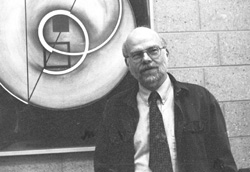

The
Man Behind the RAE Board
BY NICK STILLMAN
Deep within the bowels of Mudd Library’s administrative offices, Library
Director Ray English is sitting in his office, trying to get some work
done while gazing at works of modern artists like O’Keefe, Kandinsky
and John Pearson that adorn his walls.
 (photo by Kate Silverman) |
English is a busy man. Not only is he
responsible for Mudd Library but for the branch libraries as well. He
works with a large staff of library employees, focusing on building
and preserving the collections and instructing patrons on how to efficiently
use library resources. He is helping instruct a library internship program
that seeks to introduce a more diverse pool of students to the field
of librarianship.
On top of all this, every week English answers a host of questions students
post on the RAE Board, a bulletin board just inside Mudd’s entrance.
“I have a couple boxes of old RAE Board questions,” English said with
a chuckle.
The questions and comments English receives run the gamut — from rants
about Mudd’s sleep-inducing climate to Dear Abby-ish self-help questions,
but English dutifully answers them each Sunday. Although many have questioned
on the RAE Board whether or not “RAE” actually exists, English said
he doesn’t intentionally cultivate any mystery about his identity. “For
the most part I’m answering the questions when not that many people
are here,” he said. “There’s also something anonymous about how the
messages are signed with just my initials.”
Historically, the hottest RAE Board debate has involved the “Falling
Man” painting, prominently seen when walking to and from Mudd’s A-Level.
The work is somewhat apocalyptic, depicting a man falling and gripping
his head against an abstract red and black backdrop. “When ‘Falling
Man’ first went up students by and large despised it,” English said.
“They thought it was depressing and the last thing they needed to see
during finals.”
One of English’s first substantial challenges upon becoming library
director in 1990 was how to treat a student’s request that “Falling
Man” be removed. “I opened it up to debate,” English said. “After a
torrent of response it seemed that “Falling Man” was inviolable to the
Mudd tradition.” English expressed hope that he may acquire a lazy susan
to attach to the back of the painting so as to rotate it occasionally.
During the first semester’s reading period, English re-hung the painting
horizontally, inspiring many to re-name the work “Sit-up Man.”
English said that if popular sentiment obviously favored the removal
of “Falling Man” he wouldn’t hesitate to do it. “”It’s not like it’s
some kind of holy grail,” he said. “But I don’t get the impression that
people seriously get depressed by it.”
A Mudd controversy that transcended the RAE board took place in the
early 1990s when the General Faculty abolished smoking in campus buildings.
“Students were very attached to smoking in Mudd,” English said. When
it became clear that the resolution was final, several ambitious students
held a “smoke-in” in the lobby of A-Level. “I went to talk to them and
my clothes really stank afterward,” English said.
Another facet of English’s job entails deciding on works of art to be
displayed and attempting to integrate them with Mudd’s architecture
and design. Most of the pieces have been donated, while some are on
loan or have been purchased. “I try to pick [works of art] that I think
fit with Mudd’s decor,” English said. “In general contemporary art fits
better in a building like this where the style is modern.”
English also said that he aims to preserve Mudd’s retro aesthetic as
much as possible. “To the extent we can I’d really like to maintain
a lot of Mudd’s original look,” he said. Still, some elements, such
as the zebra-print carpets, are no longer readily available like they
were in 1974 when Mudd was constructed.
This charming modernist design and the proliferation of art on the walls
make Mudd an attractive location for students to study and socialize.
“There are various reasons why Mudd is so intensely used,” English said.
“Oberlin is a very intense academic environment, Mudd is an attractive
building and we don’t have a new and attractive student union so Mudd
takes on a social function — I’ve been giving a lot of conscious thought
about maintaining the building’s attractiveness.”
English is also aware of another student activity that takes place in
Mudd — sleeping. “The phenomenon is an old one,” English said, referring
to a film made by previous Library Director William Moffett entitled
Sleeping in Mudd.
Aside from being a self-proclaimed contemporary art buff, English is
also a guru of Oberlin history — not necessarily by choice, but because
he believes it helps him be a better library director. His book shelves
feature several hardcover books with the words ‘Oberlin College’ appearing
at some place on the bindings. Various photographs just outside the
door of his office depict various stages in the history of Oberlin’s
two previous libraries — Carnegie and Spear.
On the totem pole of English’s job description, the RAE Board is fairly
low on the list of priorities. Still, to the general public, English
is best known for his witty answers to the bizarre questions appearing
on the Board. And it’s clear that he enjoys doing it. “I’d like to think
we’re a responsive library system — the Board is a way to be responsive
and for students to help us manage the library,” he said, pausing —
inspired by a new idea. “Maybe we should have a retrospective.”
![]()
CDS Finalists Chosen; Marriot Not In Running
Trans Awareness Week Transcends
Faculty Diversity Is A GF Priority
Findley State Park Offers Breath of Fresh Air
Transgender Speaker Call For Cooperative Activism
Tradition Continues, Two OC Seniors Win Watson
Grounds Claims Nationalism Behind Racist Mascots